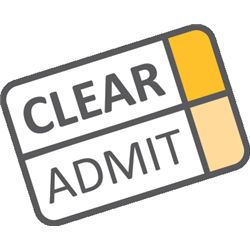As many of our readers know, U.S. News & World Report is scheduled to release its annual ranking of leading MBA programs next week. We wanted to use this time—ahead of the ranking’s release—to highlight some key insights from our MBA DecisionWire data, which we think will provide context for the upcoming rankings and perhaps even foretell some of the results.
Our analysis of DecisionWire data yielded some fascinating findings that we believe support a tiered ranking system for schools, one in which the peer group a school finds itself in serves as a better indicator of program quality than a school’s ordinal ranking. As always, with MBA DecisionWire, we preface our analysis with a reminder that we’re still dealing with a relatively modest sample size. Of course, the more of you who upload your results, the better MBA DecisionWire and these analyses will become.
“With this analysis, we are delighted to see MBA DecisionWire’s multiple benefits emerge,” says Graham Richmond, Clear Admit co-founder. “In addition to providing applicants with a fantastic platform for sharing admissions results and assisting one another in making enrollment decisions, DecisionWire has also furnished a wealth of valuable data. And as we dig into that data, we find increasing evidence to support the grouping of schools into tiers rather than in a more traditional, ordinal ranking.”
What We Did: Identify Cross Admits, Establish Peer Groups
This exercise was very straightforward. We examined 16 of the leading MBA programs in the United States, identifying each program’s most common “cross-admit” schools. Cross-admit schools are pairs of schools at which an applicant who applied to and was admitted to one also applied to and was admitted to the other. Below, we have listed each school’s top six cross-admit schools in order of overlap and then analyzed whether and how cross-admit data supports our proposed tiered ranking system of schools.
When identifying the six most common cross admits for each school, we based our calculations on the percentage of a school’s admits, rather than the raw number. The results are presented below.
MBA DecisionWire Cross Admits
(In Order of Percentage of Shared Admits)
MAGNIFICENT 7
The Magnificent 7 schools are listed below in bold in alphabetical order in the left-hand column. Each school’s corresponding cross-admit schools are listed in the right-hand column, in order of percentage of shared admits.
| Chicago Booth | Wharton, MIT, Kellogg, Columbia, tie: Harvard and Tuck |
| Columbia Business School | Wharton, MIT, tie Stern and Chicago, Yale, Stanford |
| Harvard Business School | Stanford, Wharton, MIT, Kellogg, tie: Chicago and Tuck |
| Kellogg School of Management | Haas, Chicago, Harvard, Tuck, Ross, Wharton |
| MIT Sloan | Wharton, Stanford, Columbia, Chicago, tie: Harvard and Haas |
| Stanford GSB | Harvard, MIT, Haas, Yale, Wharton, Columbia |
| Wharton School | MIT, Chicago, Harvard, Columbia, Stanford, Stern |
Key Takeaway: For the above seven schools, commonly referred to as the Magnificent 7 or M7, all except Kellogg count four or more other M7 schools among their cross-admit schools. Additionally, all schools count either Harvard and Wharton, Harvard and Stanford or Stanford and Wharton as peer schools, and some count all three.
FAB FOUR
The Fab Four schools are listed below in bold in alphabetical order in the left-hand column. Each school’s corresponding cross-admit schools are listed in the right-hand column, in order of percentage of shared admits.
| Berkeley Haas | Kellogg, tie: Anderson and Marshall, Stanford, Harvard, MIT |
| Dartmouth Tuck | Darden, Yale, Duke, tie: Cornell and Ross, Kellogg |
| NYU Stern | Yale, Columbia, Wharton, tie: Anderson and Haas, Chicago |
| Yale SOM | Stern, Stanford, Tuck, MIT, Haas, tie: Columbia and Duke |
Key Takeaway: For the above four schools—which we would argue constitute the tier below the M7 schools—only Haas counts more than one of the Harvard, Stanford, Wharton trinity as a peer school. Where Haas has four M7 schools as peer schools, Tuck has only one. What distinguishes this group from the next tier is that none of the schools has a peer school that is outside of the 16 schools in our broad analysis.
FANTASTIC FIVE
The Fantastic Five schools are listed below in bold in alphabetical order in the left-hand column. Each school’s corresponding cross-admit schools are listed in the right-hand column, in order of percentage of shared admits.
| Cornell Johnson | Duke, tie: Kenan Flagler and Tepper, tie; Georgetown and Darden, Tuck |
| Duke Fuqua | Ross, Cornell, tie Darden and Kenan Flagler, Tuck, Yale |
| Michigan Ross | Duke, Darden, Tuck, Cornell, Georgetown, Tepper |
| UCLA Anderson | Marshall, Haas, Ross, Stern, Duke, Cornell |
| UVA Darden | Kenan Flagler, Tuck, Tepper, Duke, Ross, Cornell |
Key Takeaway: For schools within this tier, none lists an M7 school as a peer and each includes at least one peer school from a tier below the tiers we have listed.
This analysis of DecisionWire data is incredibly helpful in terms of framing the peer groups and tiers that exist within the very best American business schools. “We have advocated a tiered ranking system now for some time, and I think this data helps support that idea,” says Clear Admit’s Alex Brown. “As we draw even more entries on DecisionWire, we will be able to further test the data and its support of the proposed tiers.” Notably, Berkeley’s Haas School of Business proved the most surprising program in this initial analysis. “Our data suggests it’s almost comparable with some of the group of M7 schools,” Brown adds.
Stay tuned for additional analysis of DecisionWire data, as well as complete coverage of the 2017 U.S. News & World Report business school rankings, due out March 14th. As always, those of us here at Clear Admit encourage prospective applicants to use rankings as just one of many means of evaluating target business schools.






